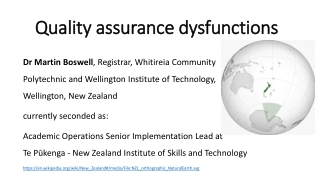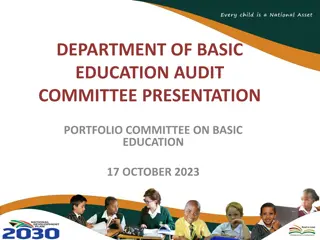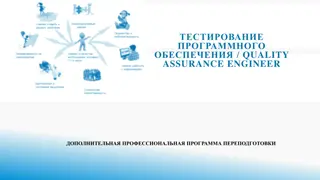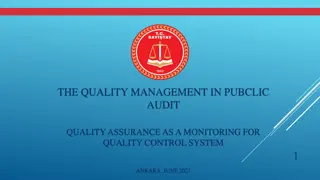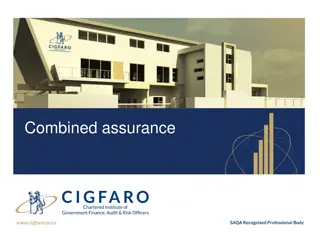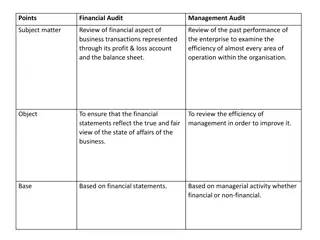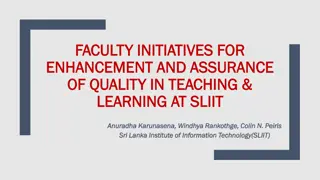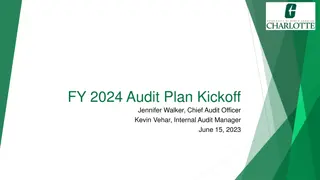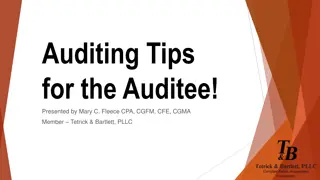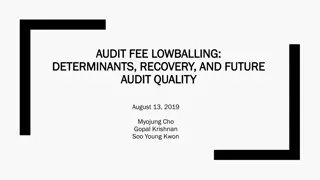Developing Robust Audit Practices for Enhanced Quality Assurance
Explore the key components of effective audits, including collaborative auditing models, qualitative data analysis, and fostering a culture of learning and improvement. Learn how audits drive positive impacts on children and families, support improvement plans, and inform decision-making processes. Understand the importance of quality assurance in monitoring and enhancing service quality, emphasizing continuous learning and reflection.
Download Presentation

Please find below an Image/Link to download the presentation.
The content on the website is provided AS IS for your information and personal use only. It may not be sold, licensed, or shared on other websites without obtaining consent from the author.If you encounter any issues during the download, it is possible that the publisher has removed the file from their server.
You are allowed to download the files provided on this website for personal or commercial use, subject to the condition that they are used lawfully. All files are the property of their respective owners.
The content on the website is provided AS IS for your information and personal use only. It may not be sold, licensed, or shared on other websites without obtaining consent from the author.
E N D
Presentation Transcript
What do good audits look like? Workshop to develop robust audits in Luton
Quality is never an accident; it is always the result of high intention, sincere effort, intelligent direction and skillful execution; it represents the wise choice of many alternatives. ~William A. Foster
Ofsteds ILAC findings July 2022 An effective and focused model of collaborative auditing is increasingly embedded. This provides an opportunity to review support that has been given to children and their families and incorporates the views of children, parents, practitioners and managers. Concluding with a closing the loop process that monitors the delivery of actions identified by auditors, these audits are effective in driving improvement in the support provided to individual children, as well as providing a clear line of sight for leaders . (p10, para 50)
How do we know what we think we know? Audit provides qualitative data that helps us understand what is working well and where attention is required to improve practice Audit data sits alongside performance data to provide a holistic overview of compliance and quality Informs improvement plans Supports learning from good practice Underpins a culture of learning and improvement Demonstrates how we are making a difference and having a positive impact on the lives of the children and young people s we work with
What do we mean by Quality Assurance & Learning culture? Effective quality assurance is dynamic and is more than just routinely counting numbers, meeting targets and periodically carrying out audits Our continuous cycle of monitoring, joint reflection, collaboration and learning, are based upon the principle that there is always room for improvement Quality assurance must to be owned by everyone in the organization; managers at all levels should understand and routinely undertake quality assurance activity on their individual supervisees, teams and service areas Most importantly, we need to get behind data trends to fully understand the lived experience of those receiving a service from us.
Weak system & unsafe practice Robust, resilient processes Safe and effective practice CP Chair / IRO Monitoring Social Work Practice Management Oversight Supervision Quality Assurance Continuum
Essential components of the Collaborative Audit Feedback from the Child / young person Feedback from the grand/parent/ connected / foster carer Collaborative discussion between the auditors and the practitioner Objectivity measured against the Luton Bottom Lines Judgement (Outstanding, Good, Requires Improvement, Inadequate) Clear rationale which includes DETAIL and ANALYTICAL summary of: The IMPACTof our intervention on improving the child s lived experience The PROGRESS of the plan The DIFFERENCE we have made / are making
Audits: the current position The number of primary audits completed in each cycle has decreased since the last Ofsted July 2022 The quality of the audits remain variable The rationale needs to be strengthened: IMPACT, DIFFERENCE, PROGRESS We need to have a shared understanding of what Good looks like, to ensure the rationale and judgements align Primary and Moderator auditors need to address ALL bottom lines in each section of the audit
What does Good look like? Ofsted provide descriptions of what good looks like in the ILACS framework Luton Practice Framework and Expectations tells us what good looks like in Luton Tri.X provide operational procedures which must underpin practice We all have practice experience and wisdom Children and young people tell us what good looks like
Writing mindfully Review your record through the following lens: Write as if; The child or young person is looking over your shoulder as you write; how would they feel about what you have written the care taken, the tone, acronyms? Your records are required by and read in Court You are writing for a stranger: a social worker new to the case, or EDT colleagues, who need to understand Your records are being read in 10 years time Your young person has requested, and is reading their record as an adult.
Activity Applying Guidance to Your Cases The remainder of this session will provide the opportunity to unpack what Good looks like, when it comes to evidencing audit judgements against the 7 domains which will be audited, which are sometimes referred to as The Magnificent 7 Individually and together, we will consider how we can provide analytical rationale in each of the sections using the Bottom Lines, Practice Framework, Ofsted criteria and Tri.X Procedures as guidance 1. What would you expect to see on the file? 2. What IMPACT, DIFFERENCE and OUTCOME does it make
Basic File Health Check Why is the Basic File Health Check information important? Includes essential information regarding the child s identity, professional involvements, family relationships, disability, ethnicity, languages / dialects, religion, parental contact details, and includes a cultural genogram What is the impact of the aspects that are in place? What is the impact if these are not accurate, up to date, not in place?
File Health Check Luton Bottom Lines Demographic information is accurate and up to date (ethnicity, gender, D.O.B., PR, NoK, MC etc.) Household members and extended family relationships are listed Current address and contact number is correct and recorded on file Health, Educational Health Care Plan, disability recorded and appropriate flags are highlighted on LCS/EHM indicating Missing/MAGPAN/MARAC etc. Professional and External involvements recorded Genogram (Cultural) recorded on the child s file
Example Basic File Health Check Moderation Demographic information is accurate and up to date (ethnicity, gender, D.O.B., PR, etc.):Jamila, I agree with your social worker s team manager and the primary auditor, Anna s assessment that your ethnicity, gender, date of birth, parental responsibility, next of kin and main carer are all recorded. I can see that English is your first language, and that you and your family are Roman Catholics. Household members and extended family relationships are listed : I agree with Anna's assessment that your household members and wider extended family relationships are recorded well, enabling an independent reader to understand who is important to, and can support you as part of your plan. Current address and contact number is correct and recorded on file?: I agree with Anna's assessment - your mum and dad's telephone numbers, as well as your mum's email are included, which is very helpful to anyone who does not know you and your family, or our out of hours team so they can be contacted in emergency. Health, Educational Health Care Plan, disability recorded and appropriate flags are highlighted on LCS/EHM indicating Missing/MAGPAN/MARAC etc.: I can see you have a 'CWD' flag Jamila. As someone who does not know you, I can see and understand under 'Additional' your disability is 'emotional or behavioural' and 'Autism or Asperger's'.
Example Basic File Health Check Moderation ctd. I can see under your Liquid Logic Additional tab, that your Education Health Care Plan (sometimes called an EHCP), is due to be completed shortly, and that you had an Educational Psychological Assessment completed in 2021. Professional and External involvements recorded : I agree with Anna's assessment that the professionals who support and know you well, are all included under Involvements tab. Cultural Genogram recorded on the child's file : I can see in Documents there is a hand drawn cultural genogram which covers 3 generations of your family. It reflects your mum and dad's new partners, that you don't have contact with your birth dad, and like to spend time with your nan and grandad. I can see that you have Roman Catholic as your faith; it would be helpful to understand whether you are practicing, and what this means for when we might visit, how we get alongside and support you. Notwithstanding these additions, I would assess this section of your record, like Anna, to be Good.
Case Summary The Case Summary is an important source of information for Colleagues, Team Managers, Service Directors and EDT in the absence of the case holder, and so it must be up to date The case summary should succinctly capture the beginning, middle and end (why are we involved, what are we doing about it, what s our planned outcome) of the child/young person s journey through children s social care Case summary should be updated every 4 weeks Case summary must follow the approved Luton template
Example Case Summary Bottom Lines Case summary follows the approved format and headings Next steps are clear Updated within the last month Link to Luton Case Summary Headings: https://lutonbc.sharepoint.com/:w:/r/sites/childrens- services/_layouts/15/Doc.aspx?sourcedoc=%7BFD2F71A6 -DFD0-4488-A0B2-3044460E1937%7D&file=Case- summaries- template.doc&action=default&mobileredirect=true
Example Case Summary Moderation Case summary follows the approved format and headings : I agree with Anna that all but one heading reflect our Practice Framework. I have read you are close to your nan and grandad (your mum's mum and dad) and that they play an important and active role in your life, including as important people in your safety plan. For this reason, they need to be included as 'Significant Family Members', with their names, which enables anyone who doesn t know you, to understand that they are clearly very important to you, and also play an important role in your safety plan. Next steps are clear : The next steps are clear; I have read Bradley your social worker, is working with your school to ensure your Education Health Care Plan (called an EHCP), is progressed quickly. I'd like next to these, there to be a date which they are due to be submitted / reviewed. This reassures me, as an independent reader or your record that Bradley is effectively driving your plan of support, ensuring other agencies do what is needed to meet your very own needs to enable you to thrive.
Example Case Summary Moderation ctd. Updated within the last month : This was last updated as Anna says, on 10th February. As this needs to be updated every 4 weeks, it is in time scales. I find really helpful the Pen Picture Bradley your social worker, has written about you; it is not only written in your voice so I can understand how you might communicate, it is really helpful for any of Bradley's colleagues in helping them understand what is important to you, and what they might want to talk to you about to enable you to feel able to speak. I can see you love horses, and you were able to speak with Bradley while playing with a toy horse he brought with him when he met you as part of his plan of direct work. I really like your Safety Plan; it is clear, easy to understand and gets to the points of how you will be safeguarded and by whom, as well as what you can do, and who you feel able to talk to. It is clear this has been developed with you and your mum by Bradley and makes me confident you know who you can talk to if worried.
Activity: Applying Bottom Lines for Basic File Health and Case Summary, to your chose record By the end of 30 minutes, you will have: Strengthened your record s Basic File Health, and Case Summary Utilised the support of your assigned Audit, QA and Practice Improvement Officers
Chronology Be used by practitioners as an analytical tool to help them to understand the impact, both immediate and cumulative, of events and changes on the child or young person's developmental progress Provide a way for a worker who is allocated a family, who return to an involvement with social care, to quickly see a pattern of events, issues and intervention over their family history Used to inform assessments Notes the key decisions made in a child's life Includes analysis, and patterns and themes against each meaningful entry to aid understanding Provides the child when they come to read their record, a means of understanding the key events in their lives, what went well, what we were worried about, and what we did, to enable them to be safer.
Chronology Bottom Lines Chronology is up to date (it has been updated within the last 4 weeks) There is analysis, patterns and themes within the chronology next to each entry, which to inform assessments Chronology links to findings from statutory intervention and also includes periods of Family Partnership interventions (prev Early Help)
Example Chronology Moderation Chronology is up to date: I agree your Chronology Jamila, to be Good. When you read your record, it will help you make sense of the key events in your life which have brought you to our attention when professionals have been worried about you, and to understand what we did to help, support and safeguard you. It will help us understand what has gone well for, and is important to you; what has worked well in the past, and what has been less helpful to you. I would like to see it including when your mum and dad were together, until when you had contact with your dad, why this stopped, and the impact upon you. I can see that your social worker is currently thinking about how best to engage you about aspects of your sexualised behaviour, and she is wondering about what might have influenced this.
Example Chronology ctd. There is analysis within the chronology that helps to informs the assessments: I agree with Anna the primary auditor, that there is analysis for the entries included so far in your chronology. Chronology links to findings from statutory intervention and also includes periods of Family Partnership interventions (prev Early Help): I can see our Family Partnership Service has supported you. Referrals associated with this, and since, and our decision and this impact upon you, as well as the key events are included, and provide a full understanding of referrals, their reasons, our response and impact for you.
Assessment, minutes and reports Good assessment matters. It is key to effective intervention and to improving outcomes for children Significant decisions are made on the basis of social work and other professional assessments that affect outcomes for children in both the short and the long term Assessments analyse information and what this means for the child (IMPACT)
Assessment, minutes and reports Bottom Lines The level of risk is clearly identified and the next steps are also clear about what actions to take to minimise risk The assessment takes into account the presenting issues from the referral Reports/assessments/minutes have been completed within specified timescales The child s wishes and feelings are apparent and their voice has contributed to the assessment conclusions Weight and analysis is evident in the recording relevant to the family/child history. Evidence of involvement with, and information gathering from multi-agency partners is incorporated into the assessments The Family Network Meeting has taken place There is evidence in the use and review of tools that the work is making a difference? for example GCP2, Pan Bedfordshire Exploitation Toolkit, Missing Risk assessment etc.
Example Assessment, minutes and reports Moderation The level of risk is clearly identified and the next steps are also clear about what actions to take to minimise risk:The assessment takes into account the presenting issues from the referral: I agree with Anna that your level of risk which is reflected in the Referral, is outlined in the Single Assessment. There are clear, and largely timely actions to address the key concerns which led to the referral being made. These are tailored to your specific needs and are aimed to improve the quality of your life for you, your mum and family. Reports/assessments/minutes have been completed within specified timescales:I agree that your single assessment was completed within Luton s time scales. The child's wishes and feelings are apparent and their voice has contributed to the assessment conclusions?: While you are not directly quoted, the wide- ranging information Bradley included enables me to have a good understanding about your appearance, personality and behaviour. Of your love of animals, and dogs and horses in particular, which is helpful for anyone who does not know you, but needs to meet with you and your mum in Bradley's absence. These are all subjects you will happily to talk to your social workers about.
Assessment, minutes and reports Moderation Weight and analysis is evident in the recording relevant to the family/child history: I agree with Anna that this is included in your assessment and reflects upon your not wanting to have contact with your dad. It is great to hear that you have protective and caring people in your life, in your nan and grandad and your mum's partner who you are said to be very fond of. Evidence of involvement with, and information gathering from multi-agency partners is incorporated into the assessments: There is an excellent range of information from the people who know you well and who you have been assessed by in your single assessment. This provides someone like me who doesn't know you, a great understanding of your needs, what support is being offered to support you, and what is outstanding and needs to be in place to reduce our worries.
Assessment, minutes and reports Bottom Lines Moderation The family network meeting has taken place, if appropriate: I agree that a family networking meeting is not needed at this point, as you have a number of adults in your family who are important to, and protective of you already in place. There is evidence in the use and review of tools that the work is making a difference? for example GCP2, Pan Bedfordshire Exploitation Toolkit, Missing Risk assessment etc.: I agree that your social worker is thinking creatively to get to know you, and develop your trust in him. He recognises the importance of animals to you, which will enable you to feel he understands what is important to you.
Planning Plan is an important tool for families and professionals to use in working together to achieve the necessary outcomes for children Plans will follow on from the assessment of need/risk The plan is the vehicle to reduce risk and achieve positive outcomes (DIFFERENCE) Actions need to be attributable to a named individual, and be specific, measureable, achievable, realistic, and time bounded
Planning Bottom Lines The Plan describes who will do what, and when, to keep the child safe and is taken into account from the most recent assessment/ report Agencies have contributed to the delivery of the plan The parents / carers and children are engaged, and evidence provided that their engagement in direct work is making a difference There is evidence of progress that the plan is making a difference For CP and LAC, there is evidence that there is a clear IRO footprint and evidence of driving progression of the plan
Example Planning Bottom Lines Mod The Plan describes who will do what, and when, to keep the child safe and is taken into account from the most recent assessment/ report: Your Child in Need Plan outlines clear actions to keep you safer. Since your first initial Child in Need meeting on the 12th January I can see that as planned, another was held on 10th February; this is yet to be fully completed, and is in good Draft at the point of audit and needs to be finalised. Having caught up with your social worker, it is clear that your plan is progressing - in particular, your EHCP. This will benefit from being reflected in your Plan. Update as of 2nd March since the initial meeting with your social worker, Bradley has completed the minutes; I can see from the last meeting, that most actions are being progressed. I can see from this, more information about your sexualised behaviour.
Example Planning Bottom Lines Mod. You are now aged 11 Jamila, which is the age of criminal responsibility and we would be keen that your behaviour towards others is not harmful. Equally, safeguards for you, would need to be considered both online and in person, as you could be vulnerable to grooming and exploitation. Gentle curiosity around what might be influencing your behaviour would usefully undertaken if the behaviour continues, as would some direct work around appropriate and inappropriate touch. I can see work around who you trust and could ask for help, has been completed with you. Agencies contributed to the delivery of the plan: Partners who know you and are getting to know you well, were invited and have contributed to your plan in both the January and February meetings.
Example Planning Bottom Lines Mod. The parents and children are engaged, and evidence provided that their engagement in direct work is making a difference: The feedback from your mum at the beginning of February is lovely to read Jamila; this can be found at the beginning of this audit form. It is clear from this and from your single assessment that both you and your mum are having the conditions in which trust can build, created by Bradley. Minutes of meetings evidence progress that the plan is making a difference: Some of the actions which were identified are being progressed, and some, such as gaining a clear diagnosis and securing an Education Health Care Plan for you, have been or are about to be achieved. Bradley is effectively working with the professionals who you and mum need, and is coordinating and following up between the Core Group Meetings to ensure our support of you and your family is making a positive difference. For CP & LAC there is evidence that there is a clear IRO footprint and evidence of driving progression of the plan: You do not have an IRO as you are not looked after or supported under a child protection plan.
Practitioner Practice Practice in Luton reflects Considerate, Courageous, Curious Conversations and practice with children, families, professionals and colleagues Our Luton Practice Framework provides a framework within which Social Work and Family Partnership support is situated The quality of practice directly influences the impact of our assessment, planning, and intervention, all of which influence the OUTCOMES, for our children young people and their families
Practitioner Practice Bottom Lines Visits are up to date and clearly recorded on child's file Parent and Child engagement clearly evidenced on file Case notes are clear for reader to understand and contain no jargon Case notes reflect activity required from the plan Worker has included next steps within case notes There is evidence of reflection and analysis on practice/ involvement Practice standards and expectations are implemented
Example Practitioner Practice Mod Visits are up to date and clearly recorded on child's file : I agree the visits taking place on 09,10.22; 20.11.22, 17.12.22, 18.01.23, 22.01.23 and 19.02.23 and are up to date. Parent and Child engagement clearly evidenced on file : It is clear that you and mum are met with, including at times apart from each other, which is helpful in giving you both space to speak with Bradley. Case notes reflect partnership working : It is clear that Bradley is working in close partnership with a range of pertinent and relevant professionals who are engaged in your child in need plan and who know you well. Case notes are clear for reader to understand and contain no jargon : I agree that the case notes when you come to read them, are clear and do not contain jargon.
Example Practitioner Practice Case notes reflect activity required from the plan : I agree with Anna that your case notes and visits reflect activities identified in your plan. In considering direct work, I love that your social worker on the 20.01.23 when he met with you, used very effectively the 3 Houses to help to understand what is important to and what worries you, which will inform our safeguarding and support of you. To enable you to focus, he also took with him a toy horse which you were going to name, so had planned this session well. This is very sensitive, Jamila-focused practice, which is enabling you to feel able to open up about some of the difficult memories you have from spending time with your dad.
Example Practitioner Practice I really liked that Bradley completed your cultural genogram with your help, to better help us understand who is important to you. I can see that Bradley has reflected upon some activities which might help and support you and mum, such as the Seeds of Change and Farm Project. He spoke about going to Panel as the cost was high, and I wonder if this might be progressed to Panel which he reflected he was thinking about. I anticipate you might love these projects, and they would provide mum space to sleep and spend some time on herself which she appears very much to need to enable her to continue to care for you well.
Management Oversight and Supervision Management Oversight drives child focused plans Decisions made are clearly recorded to ensure that help and protection is provided in a timely way Supervision plays an integral role in ensuring that staff are able to achieve the best outcomes for the children and families that they work with. It is a process that should be open and supportive, focussing on the quality of decisions, good risk analysis and improving outcomes for children, rather than meeting targets. [Laming, 2009, para 3,15]
Management Oversight and Supervision Bottom Lines Supervision is evidenced on child's file and completed in accordance with practice standards Supervision recording demonstrates an understanding of the plan and evidences progression of the plan There is evidence of management direction on case notes Detailed management sign off is evident on assessments, reports and plans Management oversight and actions evident in regards to complaints or escalations are completed in line with practice standards
Management Oversight and Supervision Bottom Lines Supervision is evidenced on child's file and completed in accordance with practice standards : I agree with Anna that supervision is completed every 4 weeks. Since her audit, I can see a further supervision took place with Bradley on the 1st March within time scales. Supervision recording demonstrates an understanding of the plan and evidences progression of the plan : Yes, very clearly. The key actions from your plan are tracked during, and between supervision, and these are appropriately raised with, and followed up by Bradley. There is evidence of management direction on case notes : There is clear management direction and intervention in your record. Anna regularly audits your record, to ensure the demographics and other parts of your record, are up to date. She highlights clearly where actions from your Child in Need Plan are drifting and identifies what, by who, and by when, these need to be progressed. I can see that Anna has escalated the need for you to have an Education and Health Care Plan (EHCP) directly with SENAT. When I communicated with Bradley, he anticipated your EHC Plan would be completed by 05th March 2023. This would be brilliant progress; your team manager reflects in her email on 06.02.23 to SENAT that this has drifted. Creation of your EHC Plan will be vital in enabling your hours of education to increase from the current 2 hours per day, which is identified in your plan, and currently has not increased.
Example Management Oversight and Supervision Detailed management sign off is evident on assessments, reports and plans : I agree there is evidence of management sign off in your single assessment. Management oversight and actions evident in regards to complaints or escalations are completed in line with practice standards : There have not been any escalations or complaints. In fact, the feedback from your mum as uploaded in Documents in February, could be seen as a compliment. Your mum assesses that Bradley's support is making a positive difference to your lives which is so lovely to read.
Judgements The rationale for judgement must address all bottom lines Rationale must be analytical to provide clarity for the judgement provided IMPACT, DIFFERENCE and OUTCOME is essential to the rationale When deciding upon the overall judgement, we need to consider the judgements across all domains If some areas of inadequate practice are mitigated by aspects of good practice evident on the file elsewhere, this needs to be included in the rationale We need to ensure the feedback from the child, parent/carer is considered within the overall summary, judgement and analysis of impact and difference made Return to the ILAC criteria for good, Practice Framework and Tri.X procedures to underpin judgement
Finally, some Dos when your case is chosen for audit Review your record, and strengthen against the Luton Bottom Lines, before the Primary auditor has reviewed your record a 7 day window prior to Primary Audit beginning Collaborate with your Primary Auditor to progress any outstanding actions they identify so they can grade your record as highly as possible and can evidence the reason, prior to Moderation Collaborate with your Moderator Auditor who similarly, will reach out during the audit process, asking you to update your record, so that your good work can be reflected Attend the collaborative meeting with the Moderator Auditor so Team Manager, Social Worker / Family Partnership Worker Review any outstanding actions prior to that meeting. Agree time scales for identified actions at the Collaborative Meeting (usually 5 working days) Escalate any disagreement with overall Grading to Team Manager, QAAPI to review.
Useful Links Luton Procedures Online (Tri.X): https://www.proceduresonline.com/luton/childcare/index.html Luton Chronology Guidance: https://www.proceduresonline.com/luton/childcare/p_chronology.html Luton Case Summary Template: https://lutonbc.sharepoint.com/:w:/r/sites/childrens- services/_layouts/15/Doc.aspx?sourcedoc=%7BFD2F71A6-DFD0- 4488-A0B2-3044460E1937%7D&file=Case-summaries- template.doc&action=default&mobileredirect=true
Quality Assurance, Audit and Practice Improvement Team contact details We are here to support, and help to improve your practice, so feel free to get in touch ! QA, Audit and Practice Improvement Team Manager, natasha.sampson@luton.gov.uk QA, Audit and Practice Improvement Officers: suki.chumber@luton.gov.uk heather.oliver-parker@luton.gov.uk shireen.clarke@luton.gov.uk claire.pascoe@luton.gov.uk brenda.gee@luton.gov.uk




